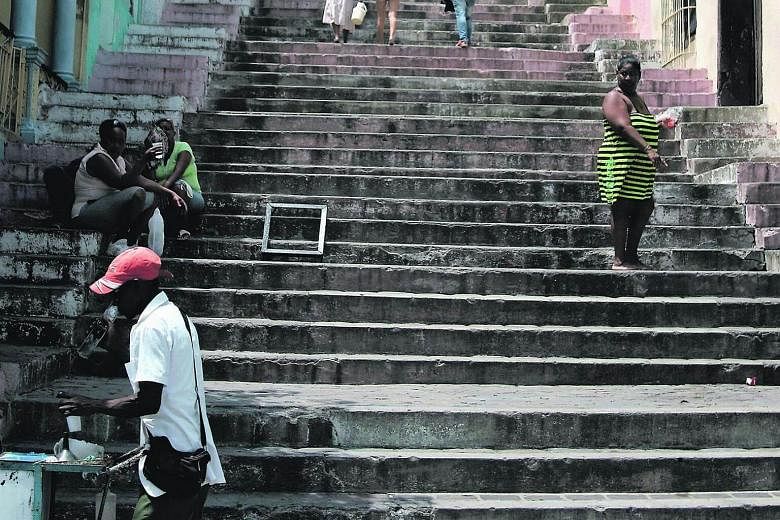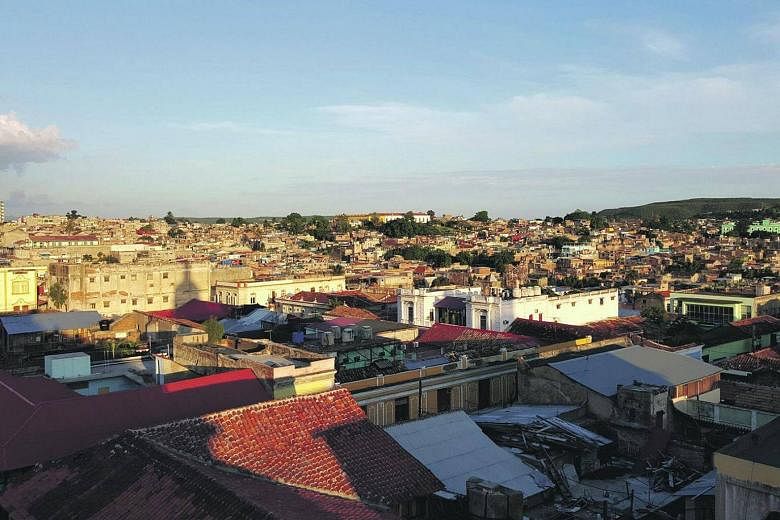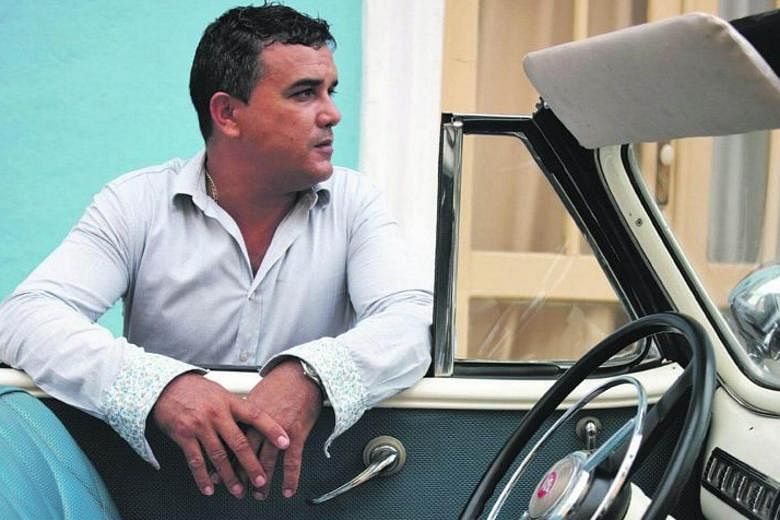SANTIAGO DE CUBA, CUBA (THE BUSINESS TIMES) - Change is coming to Cuba - and it's about time. After decades of proud isolation, this Caribbean island nation, seemingly frozen in time since 1959 and defined for so long by a heavily-bearded, cigar-smoking revolutionary in olive fatigues, is having its day in the sun.
The death of Fidel Castro last month marked the end of a major chapter in the country's history, but Cuba had been the focus of international attention before that. In the space of a few months from September 2015, Pope Francis and President Obama made high-profile visits, The Rolling Stones played a free concert in Havana, Chanel staged a fashion show on Paseo del Prado and perhaps most improbably, Hollywood came to town. Action scenes for Fast 8 - the next instalment of the Fast & Furious film franchise - were shot along The Malecon, an eight-km-long boulevard that runs along the Havana waterfront. Closer to home, a Cuban embassy opened in Singapore.
More than three million people visited Cuba (population: 11.2 million) in 2015 but numbers are expected to surge as visitors (an estimated 3.7 million this year) descend on the Cuban archipelago (comprising some 4,159 islands), drawn by an exhilarating blend of natural beauty, Latin-infused culture and a giddy sense of travelling back in time.
Proximity to the eastern United States (Florida, a mere 150 km away, is home to over a million Cuban exiles) and recent developments in US-Cuba relations (a Trump presidency notwithstanding) have led to a dramatic rise in foreign investment, although actual improvements to the country's crumbling infrastructure will take time.
Until then, delays at airports and government offices will tax the patience of 21st century travellers. The lack of tourism-related facilities can be simultaneously charming and frustrating but Cuba's unique allure, including world-class beaches, colonial towns, dazzling Afro-Caribbean dance rhythms and the surreal sight of classic Buicks and Chevrolets plying the streets, will eclipse everything else.
Add to that the friendly faces and festive spirit of citizens who will break into rumba or salsa at the slightest provocation, even if they're just walking down the street, and you have the makings of a very special destination - one that has been shaped by Spanish colonisation, a fragile period of US-influenced independence and a Communist revolution.
People are desperately poor (despite a high literacy rate and universal health care, Cuban socialism dictates that the average wage is US$25 a month) but crime is practically non-existent. Entrepreneurship in the form of paladares (restaurants in private homes) and casas particulares (homestays) is on the rise. Cuba is now Airbnb's fastest-growing market.
Owners of both pristine and patched-up classic cars congregate near The Malecon and outside hotels, waiting to snag tourists in search of a retro motoring experience. Meanwhile, government-controlled outlets do a brisk trade in Cuban rum and cigars.
Santiago de Cuba
Santiago de Cuba, a city about 880 km east of Havana, is home to rum, revolution and rhythms of the Afro-Caribbean variety (the city is much closer to Haiti and Jamaica than Havana). Cuba's second largest city was founded by Spanish conquistadors in the early-16th century and grew into a bustling port, gaining notoriety in the 1950s as a socialist stronghold and hotbed of anti-government activity.
Fidel's lifelong connection to the city (he studied here as a young boy, made a milestone victory speech in the main square in 1959 and had his ashes interred in a local cemetery earlier this month), gives it pride of place in the history of modern Cuba. Residents of the city, or Santiagueros, call it the capital moral de la Revolucion - Hero City.
These days, a revolution of a very different sort is taking place. Tourism is a fast-growing industry and outside of Havana, Santiago is leading the way. There are assorted monuments and museums to visit but the best way to understand the Cuban character is to experience it through music and dance. From Cuban Son (salsa) and rumba to dance-club reggaeton (a sort of Latin hip-hop), the musical vibes ring loud, clear and long in this city.
Everybody, from street musicians to hotel workers and tourist guides, will dance at the drop of a rhythm. Traditional clubs like Casa de la Trova offer a good platform to watch or partake in the action, but aficionados may wish to visit during July when the climate is hot and clammy and Santiago hosts its annual Carnaval, a city-wide extravaganza with its roots in the 19th-century African slave trade. Insiders rate this the best festival in the country.
Camaguey
Camaguey, about 570 km east of Havana in central Cuba, exudes a much different vibe from Santiago, even though it was founded at the same time. The city, which prospered under an agricultural and a slave-plantation economy, is characterised by its labyrinthine cobblestone streets, blind alleys and forked lanes. Non-residents will find it difficult to navigate, but you will be able to examine the colonial architecture in more detail. Depending on who you believe, the streets were built to confuse marauding pirates, or the result of a drastic lack of city planning.
There doesn't appear to be much going on in the old town - not from the tourist perspective at least - but this UNESCO World Heritage Site (with its multiple plazas and 17 churches) will elicit a sense of calm, of being somewhere quiet and discreet. If you're fortunate enough, a friendly resident will invite you into her courtyard home for some music (classical) and conversation (civilised).
Like all Cuban cities Camaguey is crumbling in parts, but locals take great pride in their colourful history and cultural heritage. Early Spanish settlers dealt with chronic water shortages by making giant earthen pots (tinajones) to collect rainfall - that's why Camaguey is known as the City of Big-Belly Pots. This city of 300,000 people has a disproportionate number of art galleries, theatres and concert venues, and boasts its own symphony orchestra. Long-time residents are fond of saying: "In Camaguey we speak Spanish, in the other cities they speak Cuban."
Trinidad
Trinidad, long considered the star in Cuba's collection of colonial towns, was - together with Santiago and Camaguey - founded by the conquistador Diego Valazquez. This well-preserved hillside town on Cuba's south-central coast is lighter on culture (compared to Camaguey) and heavy on colonial charm, with cobblestone streets (paved with large river stones), red-roofed homes and a famous son in Carlos Manuel de Cespedes, a 19th-century planter who freed his slaves and fought for independence from Spain. Many Cubans are descended from the slaves who were brought over from Africa to work on sugar plantations.
The city's heyday came during the 18th century, when wealthy traders and plantation owners built large mansions around Plaza Mayor, the main square. Nowadays, cowboys ride around offering a variety of equine (including horse-whisperer) services, while under the shade of jacaranda trees residents engage in noisy domino sessions - apparently it is de rigueur to yell and curse while playing.
Outside town, an elevated viewpoint looks out over the picturesque Valle de los Ingenios (Valley of the Sugar Mills). This was the country's most important region for producing sugar, and it's possible to visit some former mills. The San Isidro mill features a three-storey campanile, or bell tower, while the mill at Hacienda Iznaga seven-levels tall. The pathway to the hacienda is lined with outdoor stalls selling lacework, a local specialty.
Havana
On the drive from Trinidad into Havana, make a brief stop in Santa Clara to visit the Che Guevara Memorial, built in honour of the Argentine revolutionary who played a key role in Cuba's independence movement. A mausoleum holds his remains, while an adjacent museum features photographs and relics from his revolutionary past.
Even if you don't make it to Santa Clara, there's no chance that Che (like Fidel, nobody refers to them by their full names) will be omitted from your Cuba memory bank - or your picture files. Murals, souvenirs and photographs of Che are ubiquitous throughout Cuba, as is his famous quote, taken from a letter to Fidel: "Hasta la victoria, siempre!" (roughly translated, it means, "Until victory, always!").
Che is a constant reminder of the old Cuba and neither he nor Fidel will soon be forgotten, but Cuba is (slowly) catching up with the times. This is most noticeable in Havana where, even as classic cars zip down the city's famous esplanade The Malecon, faded colonial buildings in nearby Habana Vieja (Old Havana) are being restored to their former glory, new hotels are opening and trendy restaurants and bars are overflowing with local hipsters and tourists in the know.
Not for them standard destinations such as the landmark Hotel Nacional, a grande dame dating back to pre-revolutionary times when mob figures like Al Capone, Lucky Luciano and Meyer Lansky held court, or legendary Hemingway haunts (bars) like El Floridita, Sloppy Joe's and the rooftop bar of the Hotel Ambos Mundos (where the author drank, then drank some more, and where the room he stayed in has been preserved).
Instead, Cuban chic is exemplified by places like Fabrica de Arte Cubano (Cuban Art Factory), an independent art gallery/music bar/restaurant space housed in a former olive oil factory, which has turned into ground zero for local fashionistas. In addition to museums and cultural spaces, organise a tour to artists' homes, where you will get a dose of contemporary Cuban art.
Like Hemingway, it's easy to fall for Havana's myriad charms. The city's various districts, especially Centro Habana, Vedado and upscale Miramar have individual appeal and warrant exploring. There's always something to do, whether taking in the flea markets, shops and bars around pedestrian-friendly Calle Mercaderes and Calle Obispo in Old Havana, or attending the ballet, catching a baseball game and hanging out at a late-night jazz bar or al fresco salsa club. The nightlife is varied, and vibrant.
Finally, make your way across the harbour (by ferry or car) to Fortaleza de San Carlos de la Cabana, a massive 18th-century fort complex (the largest in the Americas) built by the British. There, on an embankment above the fort's bronze cannons, locals and visitors can enjoy expansive views of the fast-changing Havana skyline and contemplate life after Fidel. They have plenty to think about.
From East To West: Santiago to Havana
Many first-time visitors will confine their Cuba experience to Havana and the popular beach resort of Varadero or the picturesque tobacco-growing Vinales valley to the west of the capital. But Cuba is by far the largest island in the Caribbean (about 1,200 km long and 110,000 sq km, roughly 150 times the size of Singapore), so take the plunge and venture further afield.
One sensible option is to fly to Santiago and hire a car and driver for a leisurely east-to-west drive back to Havana on blissfully traffic-free highways (horse carts are still a common mode of transport in rural Cuba), with overnight stops in some of Cuba's colonial towns. Resist the urge to travel long distances in a classic convertible - a modern SUV will be much more comfortable.









